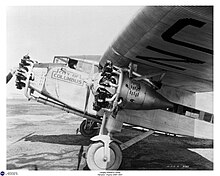|
Transcontinental Air Transport
Transcontinental Air Transport (T-A-T) was an airline founded in 1928 by Clement Melville Keys that merged in 1930 with Western Air Express to form what became TWA. Keys enlisted the help of Charles Lindbergh to design a transcontinental network to get government airmail contracts. Lindbergh established numerous airports across the country in this effort.  HistoryThe original TAT route between New York and Los Angeles  On July 7, 1929, transcontinental trips began. It initially offered a 48-hour coast to coast trip with the passengers taking flights during the day and trains by night. The first leg on the Pennsylvania Railroad departed from New York City at 6:05pm Eastern time and travelled overnight to Columbus, Ohio. There, passengers boarded a Ford Trimotor aircraft at what is now John Glenn Columbus International Airport, and flew to Waynoka, Oklahoma, an 11-hour flight that required four brief stops. At Waynoka, passengers boarded a Santa Fe Railway train for a second overnight rail trip to Clovis, New Mexico. There, they took a second Ford Trimotor flight to Los Angeles, with three stops along the way, eventually arriving at 5:52pm Pacific time at the Grand Central Airport in Glendale.[1] The return journey departed from Los Angeles at 8:45am and arrived at Now York at 9:50am of the third day.[1] The one-way fare from New York to Los Angeles was $352 ($6,246 in 2023).[2][3] The Ford Trimotor service was one of the first to offer meals en route, provided by the Fred Harvey Company.;[4] Fred Harvey also provided meals on the ground at several stops.[1] The service was also one of the first to be geared toward passengers–most airlines at the time focused on transporting air mail. Cynics were to deride the TAT abbreviation as "Take A Train". And in its first eighteen months of operation, the company lost $2.7 million ($49.2 million in 2023).[5] In November 1929 TAT bought Maddux Air Lines. The company was tendering to the United States Postal Service for the contract for the New York to Los Angeles air mail route. However, before granting the contract Walter Folger Brown, the US postmaster general forced TAT to merge with Western Air Express to form Transcontinental & Western Air (T&WA).[6] In October 1930, the new airline began an all-air, coast to coast passenger service that took 36 hours, with an overnight stop at Kansas City[7][6] Western became an independent company once again in 1934. However, Transcontinental opted to retain the T&WA name, and eventually evolved into Trans World Airlines or TWA. Accidents and incidentsOn September 3, 1929, NC9649, named City of San Francisco, crashed into the forested slope of Mount Taylor near Grants, New Mexico . The crash took place during a thunderstorm; the three crew and five passengers on board died.[8][9] The September crash was the first of three serious accidents for TAT over the next five months.[10] Legacy Two of the Ford Tri-Motors that flew the transcontinental route with TAT, are preserved in flying condition:
The Western New Mexico Aviation Heritage Museum in Grants, New Mexico, has a restored light and arrow which was used to direct pilots along the route. The United States Forest Service district office in Grants stores a collection of items of wreckage recovered from the crash site of NC9649, City of San Francisco. A USFS-sponsored, 2009 archaeological survey of the site found many other fragments of the aircraft.[9] See alsoReferences
External linksArticles
Graphics
|
||||||||||

